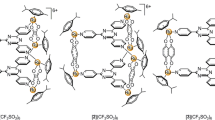Abstract
Pentaammineruthenium(III) complexes of deoxyinosine (dIno) and xanthosine (Xao) ([RuIII(NH3)5(L)], L is dIno, Xao) in basic solution were studied by UV–vis spectroscopy, liquid chromatography/electrospray ionization mass spectrometry, and high-performance liquid chromatography. Both RuIII complexes disproportionate to RuII and RuIV. Disproportionation followed the rate law d[RuII]/dt = (k o + k 1[OH−])[RuIII]. k o and k 1 of disproportionation at 25 °C were 2.1 (±0.1) × 10−3 s−1 and 21.4 ± 3.2 M−1 s−1, respectively, for [RuIII(NH3)5(dIno)], and 3.5 (±0.7) × 10−4 s−1 and 59.7 ± 3.6 M−1 s−1, respectively, for [RuIII(NH3)5(Xao)]. The [RuIII(NH3)5(Xao)] complex disproportionates at a faster rate than [RuIII(NH3)5(dIno)] owing to the stronger electron-withdrawing effect of exocyclic oxygen in Xao. The activation parameters ΔH ‡ and ΔS ‡ for k 1 of [RuIII(NH3)5(dIno)] were 80.2 ± 15.2 kJ mol−1 and 47.6 ± 9.8 J K−1 mol−1, respectively, indicating that the disproportionation of RuIII to RuII and RuIV is favored owing to the positive entropy of activation. The final products of both complexes in basic solution under Ar were compared with those under O2. Under both conditions [Ru(NH3)5(8-oxo-L)] was produced, but via different mechanisms. In both aerobic and anaerobic conditions, the deprotonation of highly positively polarized C8-H of Ru-L by OH− initiates a two-electron redox reaction. For the next step, we propose a one-step two-electron redox reaction between L and RuIV under anaerobic conditions, which differentiates from Clarke’s mechanism of two consecutive one-electron redox reactions between L, RuIII, and O2.








Similar content being viewed by others
Abbreviations
- Cyclic-dGuo:
-
Cyclic 5′-O-C8-2′-deoxyguanosine
- dGuo:
-
2′-Deoxyguanosine
- dIno:
-
2′-Deoxyinosine
- Guo:
-
Guanosine
- HPLC:
-
High-performance liquid chromatography
- Ino:
-
Inosine
- LC:
-
Liquid chromatography
- MS:
-
Mass spectrometry
- Xao:
-
Xanthosine
References
Rudd DP, Taube H (1971) Inorg Chem 10:1543–1544
LaChance-Galang KJ, Zhao M, Clarke MJ (1996) Inorg Chem 35:6021–6026
Zhao M, Clarke MJ (1999) J Biol Inorg Chem 4:318–324
Zhao M, Clarke MJ (1999) J Biol Inorg Chem 4:325–340
Choi S, Ryu D, DellaRocca JG, Wolf MW, Bogart JA (2011) Inorg Chem 50:6567–6574
Becker BF (2011) Nucleosides Nucleotides Nucleic Acids 30:1161
Vongchampa V, Dong M, Gingipalli L, Dedon P (2003) Nucleic Acids Res 31:1045–1051
Steenken S, Jovanovic SV (1997) J Am Chem Soc 119:617–618
Kim J (2000) Bull Korean Chem Soc 21:709–711
Clarke MJ, Taube H (1974) J Am Chem Soc 96:5413–5419
Clarke MJ (1977) Inorg Chem 16:738–744
Gariepy KC, Curtin MA, Clarke MJ (1989) J Am Chem Soc 111:4947–4952
Rodriguez-Bailey VM, LaChance-Galang KJ, Doan PE, Clarke MJ (1997) Inorg Chem 36:1873–1883
Subranamanian P, Ji X, van der Helm D, Dryhurst G (1990) J Org Chem 55:1291–1296
Acknowledgment
This work was supported by the National Science Foundation (grant CHE-0848072).
Author information
Authors and Affiliations
Corresponding author
Electronic supplementary material
Below is the link to the electronic supplementary material.
775_2012_942_MOESM1_ESM.pdf
MS spectra of experimental and theoretical [RuIII(NH3)5(L)] (Fig. S1). UV–vis spectra of [RuII(NH3)5(Xao)] and [RuIII(NH3)5(Xao)] along with kinetic data. (Fig. S2). k obs vs OH− concentration for the disproportionation of [RuIII(NH3)5(dIno)] (Fig. S3). k obs versus OH− concentration for the disproportionation of [RuIII(NH3)5(Xao)] (Fig. S4). ln(k 1/T) versus 1/T for the disproportionation of [RuIII(NH3)5(dIno)] at 20, 25, 30, and 35 °C. (Fig. S5). (PDF 260 kb)
Rights and permissions
About this article
Cite this article
Wolf, M.W., Choi, S. Disproportionation of pentaammineruthenium(III)–nucleoside complexes leads to two-electron oxidation of nucleosides without involving oxygen molecules. J Biol Inorg Chem 17, 1283–1291 (2012). https://doi.org/10.1007/s00775-012-0942-8
Received:
Accepted:
Published:
Issue Date:
DOI: https://doi.org/10.1007/s00775-012-0942-8




